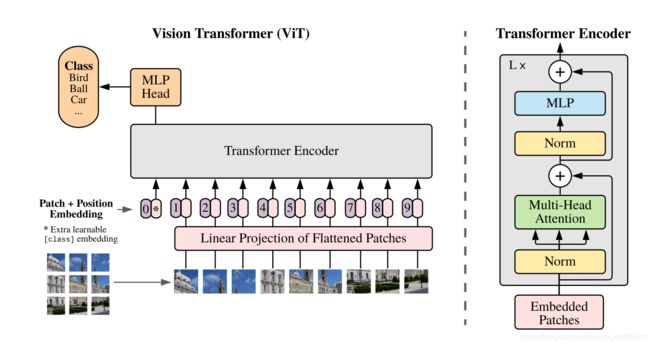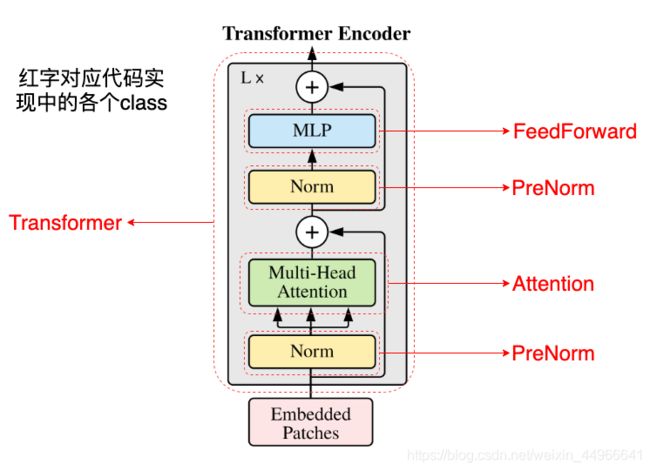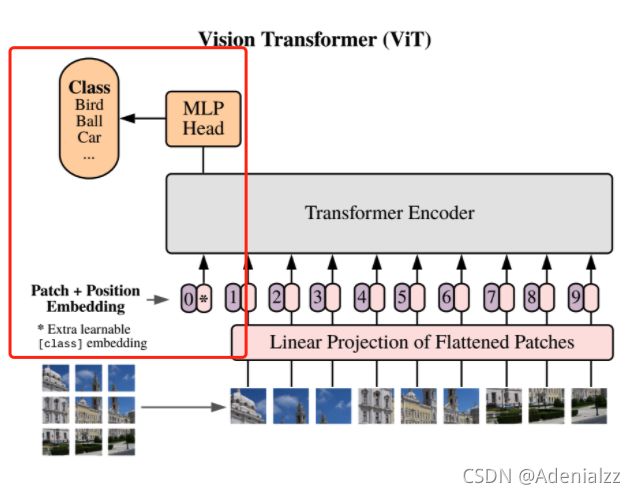Vision Transformer(ViT)PyTorch代码全解析(附图解)
Vision Transformer(ViT)PyTorch代码全解析
最近CV领域的Vision Transformer将在NLP领域的Transormer结果借鉴过来,屠杀了各大CV榜单。本文将根据最原始的Vision Transformer论文,及其PyTorch实现,将整个ViT的代码做一个全面的解析。
对原Transformer还不熟悉的读者可以看一下Attention is All You Need原文,中文讲解推荐李宏毅老师的视频 YouTube,BiliBili 个人觉得讲的很明白。
话不多说,直接开始。
以下是文中给出的符号公式,也是我们解析的重要参照:
z = [ x c l a s s ; x p 1 E , x p 2 E , … ; x p N E ] + E p o s , E ∈ R ( P 2 ⋅ C ) × D , E p o s ∈ R ( N + 1 ) × D ( 1 ) \mathbf{z}=[\mathbf{x}_{class};\mathbf{x}^1_p\mathbf{E},\mathbf{x}^2_p\mathbf{E},\dots;\mathbf{x}^N_p\mathbf{E}]+\mathbf{E}_{pos},\ \ \ \mathbf{E}\in\mathbb{R}^{(P^2\cdot C)\times D},\mathbf{E}_{pos}\in \mathbb{R}^{(N+1)\times D} \ \ \ \ \ \ \ \ \ \ \ \ \ (1) z=[xclass;xp1E,xp2E,…;xpNE]+Epos, E∈R(P2⋅C)×D,Epos∈R(N+1)×D (1)
z ℓ ′ = M S A ( L N ( z ℓ − 1 ) ) + z ℓ − 1 ( 2 ) \mathbf{z'_\ell}=MSA(LN(\mathbf{z}_{\ell-1}))+\mathbf{z}_{\ell-1}\ \ \ \ \ \ \ \ \ \ \ \ \ \ \ \ \ \ \ \ \ \ \ \ \ \ \ \ \ \ \ \ \ \ \ \ \ \ (2) zℓ′=MSA(LN(zℓ−1))+zℓ−1 (2)
z ℓ = M L P ( L N ( z ′ ℓ ) ) + z ′ ℓ ( 3 ) \mathbf{z}_{\ell}=MLP(LN(\mathbf{z'}_{\ell}))+\mathbf{z'}_{\ell}\ \ \ \ \ \ \ \ \ \ \ \ \ \ \ \ \ \ \ \ \ \ \ \ \ \ \ \ \ \ \ \ \ (3) zℓ=MLP(LN(z′ℓ))+z′ℓ (3)
y = L N ( z L 0 ) ( 4 ) \mathbf{y}=LN(\mathbf{z}_L^0)\ \ \ \ \ \ \ \ \ \ \ \ \ \ \ \ \ \ \ \ \ \ \ \ \ \ \ \ \ \ \ \ \ \ (4) y=LN(zL0) (4)
导入需要的包
import torch
from torch import nn, einsum
import torch.nn.functional as F
from einops import rearrange, repeat
from einops.layers.torch import Rearrange
都是搭建网络时常用的PyTorch包,其中在卷积神经网络的搭建中并不常用的einops和einsum,还不熟悉的读者可以参考博客:einops和einsum:直接操作张量的利器。
pair函数
def pair(t):
return t if isinstance(t, tuple) else (t, t)
作用是:判断t是否是元组,如果是,直接返回t;如果不是,则将t复制为元组(t, t)再返回。
用来处理当给出的图像尺寸或块尺寸是int类型(如224)时,直接返回为同值元组(如(224, 224))。
PreNorm
class PreNorm(nn.Module):
def __init__(self, dim, fn):
super().__init__()
self.norm = nn.LayerNorm(dim)
self.fn = fn
def forward(self, x, **kwargs):
return self.fn(self.norm(x), **kwargs)
PreNorn对应框图中最下面的黄色的Norm层。其参数dim是维度,而fn则是预先要进行的处理函数,是以下的Attention、FeedForward之一,分别对应公式(2)(3)。
z ℓ ′ = M S A ( L N ( z ℓ − 1 ) ) + z ℓ − 1 ( 2 ) \mathbf{z'_\ell}=MSA(LN(\mathbf{z}_{\ell-1}))+\mathbf{z}_{\ell-1}\ \ \ \ \ \ \ \ \ \ \ \ \ \ \ \ \ \ \ \ \ \ \ \ \ \ \ \ \ \ \ \ \ \ \ \ \ \ (2) zℓ′=MSA(LN(zℓ−1))+zℓ−1 (2)
z ℓ = M L P ( L N ( z ′ ℓ ) ) + z ′ ℓ ( 3 ) \mathbf{z}_{\ell}=MLP(LN(\mathbf{z'}_{\ell}))+\mathbf{z'}_{\ell}\ \ \ \ \ \ \ \ \ \ \ \ \ \ \ \ \ \ \ \ \ \ \ \ \ \ \ \ \ \ \ \ \ (3) zℓ=MLP(LN(z′ℓ))+z′ℓ (3)
FeedForward
class FeedForward(nn.Module):
def __init__(self, dim, hidden_dim, dropout=0.):
super().__init__()
self.net = nn.Sequential(
nn.Linear(dim, hidden_dim),
nn.GELU(),
nn.Dropout(dropout),
nn.Linear(hidden_dim, dim),
nn.Dropout(dropout)
)
def forward(self, x):
return self.net(x)
FeedForward层由全连接层,配合激活函数GELU和Dropout实现,对应框图中蓝色的MLP。参数dim和hidden_dim分别是输入输出的维度和中间层的维度,dropour则是dropout操作的概率参数p。
Attention
class Attention(nn.Module):
def __init__(self, dim, heads=8, dim_head=64, dropout=0.):
super().__init__()
inner_dim = dim_head * heads
project_out = not (heads == 1 and dim_head == dim)
self.heads = heads
self.scale = dim_head ** -0.5
self.attend = nn.Softmax(dim=-1)
self.to_qkv = nn.Linear(dim, inner_dim * 3, bias=False)
self.to_out = nn.Sequential(
nn.Linear(inner_dim, dim),
nn.Dropout(dropout),
) if project_out else nn.Identity()
def forward(self, x):
b, n, _, h = *x.shape, self.heads
qkv = self.to_qkv(x).chunk(3, dim=-1) # (b, n(65), dim*3) ---> 3 * (b, n, dim)
q, k, v = map(lambda t: rearrange(t, 'b n (h d) -> b h n d', h=h), qkv) # q, k, v (b, h, n, dim_head(64))
dots = einsum('b h i d, b h j d -> b h i j', q, k) * self.scale
attn = self.attend(dots)
out = einsum('b h i j, b h j d -> b h i d', attn, v)
out = rearrange(out, 'b h n d -> b n (h d)')
return self.to_out(out)
Attention,Transformer中的核心部件,对应框图中的绿色的Multi-Head Attention。参数heads是多头自注意力的头的数目,dim_head是每个头的维度。
本层的对应公式就是经典的Tansformer的计算公式:
A t t e n t i o n ( Q , K , V ) = s o f t m a x ( Q K T d k ) V Attention(Q,K,V)=softmax(\frac{QK^T}{\sqrt{d_k}})V Attention(Q,K,V)=softmax(dkQKT)V
Transformer
class Transformer(nn.Module):
def __init__(self, dim, depth, heads, dim_head, mlp_dim, dropout=0.):
super().__init__()
self.layers = nn.ModuleList([])
for _ in range(depth):
self.layers.append(nn.ModuleList([
PreNorm(dim, Attention(dim, heads=heads, dim_head=dim_head, dropout=dropout)),
PreNorm(dim, FeedForward(dim, mlp_dim, dropout=dropout))
]))
def forward(self, x):
for attn, ff in self.layers:
x = attn(x) + x
x = ff(x) + x
return x
定义好几个层之后,我们就可以构建整个Transformer Block了,即对应框图中的整个右半部分Transformer Encoder。有了前面的铺垫,整个Block的实现看起来非常简洁。
参数depth是每个Transformer Block重复的次数,其他参数与上面各个层的介绍相同。
ViT
class ViT(nn.Module):
def __init__(self, *, image_size, patch_size, num_classes, dim, depth, heads, mlp_dim, pool='cls', channels=3, dim_head=64, dropout=0., emb_dropout=0.):
super().__init__()
image_height, image_width = pair(image_size)
patch_height, patch_width = pair(patch_size)
assert image_height % patch_height ==0 and image_width % patch_width == 0
num_patches = (image_height // patch_height) * (image_width // patch_width)
patch_dim = channels * patch_height * patch_width
assert pool in {'cls', 'mean'}
self.to_patch_embedding = nn.Sequential(
Rearrange('b c (h p1) (w p2) -> b (h w) (p1 p2 c)', p1=patch_height, p2=patch_width),
nn.Linear(patch_dim, dim)
)
self.pos_embedding = nn.Parameter(torch.randn(1, num_patches+1, dim))
self.cls_token = nn.Parameter(torch.randn(1, 1, dim)) # nn.Parameter()定义可学习参数
self.dropout = nn.Dropout(emb_dropout)
self.transformer = Transformer(dim, depth, heads, dim_head, mlp_dim, dropout)
self.pool = pool
self.to_latent = nn.Identity()
self.mlp_head = nn.Sequential(
nn.LayerNorm(dim),
nn.Linear(dim, num_classes)
)
def forward(self, img):
x = self.to_patch_embedding(img) # b c (h p1) (w p2) -> b (h w) (p1 p2 c) -> b (h w) dim
b, n, _ = x.shape # b表示batchSize, n表示每个块的空间分辨率, _表示一个块内有多少个值
cls_tokens = repeat(self.cls_token, '() n d -> b n d', b=b) # self.cls_token: (1, 1, dim) -> cls_tokens: (batchSize, 1, dim)
x = torch.cat((cls_tokens, x), dim=1) # 将cls_token拼接到patch token中去 (b, 65, dim)
x += self.pos_embedding[:, :(n+1)] # 加位置嵌入(直接加) (b, 65, dim)
x = self.dropout(x)
x = self.transformer(x) # (b, 65, dim)
x = x.mean(dim=1) if self.pool == 'mean' else x[:, 0] # (b, dim)
x = self.to_latent(x) # Identity (b, dim)
print(x.shape)
return self.mlp_head(x) # (b, num_classes)
笔者在forward()函数代码中的注释说明了各中间state的尺寸形状,可供参考比对。
在 x 送入transformer之前,都是对应公式(1)的预处理操作:
z = [ x c l a s s ; x p 1 E , x p 2 E , … ; x p N E ] + E p o s , E ∈ R ( P 2 ⋅ C ) × D , E p o s ∈ R ( N + 1 ) × D ( 1 ) \mathbf{z}=[\mathbf{x}_{class};\mathbf{x}^1_p\mathbf{E},\mathbf{x}^2_p\mathbf{E},\dots;\mathbf{x}^N_p\mathbf{E}]+\mathbf{E}_{pos},\ \ \ \mathbf{E}\in\mathbb{R}^{(P^2\cdot C)\times D},\mathbf{E}_{pos}\in \mathbb{R}^{(N+1)\times D} \ \ \ \ \ \ \ \ \ \ \ \ \ (1) z=[xclass;xp1E,xp2E,…;xpNE]+Epos, E∈R(P2⋅C)×D,Epos∈R(N+1)×D (1)
positional embedding和class token由nn.Parameter()定义,该函数会将送到其中的Tensor注册到Parameters列表,随模型一起训练更新,对nn.Parameter()不熟悉的同学可参考博客:PyTorch中的torch.nn.Parameter() 详解。
我们知道,transformer模型最后送到mlp中做预测的只有cls_token的输出结果(如上图红框所示),而其他的图像块的输出全都不要了,是由这一步实现:
x = x.mean(dim=1) if self.pool == 'mean' else x[:, 0] # (b, dim)
可以看到,如果指定池化方式为'mean'的话,则会对全部token做平均池化,然后全部进行送到mlp中,但是我们可以看到,默认的self.pool='cls',也就是说默认不会进行平均池化,而是按照ViT的设计只使用cls_token,即x[:, 0]只取第一个token(cls_token)。
最后经过mlp_head,得到各类的预测值。
笔者也简单做了一张图展示整个过程中的信号流,可以结合代码中注释的维度的变化来看:
图中各符号含义: H , W , C H,W,C H,W,C 分别是某一张输入图像的长、宽、通道数, h , w h,w h,w 是图块的长、宽,如此这张图中块的个数就是 H h × W w \frac{H}{h}\times \frac{W}{w} hH×wW ,用 N p N_p Np 表示, D D D 是维度数dim, N c N_c Nc 是类的个数。
至此,ViT模型的定义就全部完成了,在训练脚本中实例化一个ViT模型来进行训练即可,以下脚本可验证ViT模型正常运作。
model_vit = ViT(
image_size = 256,
patch_size = 32,
num_classes = 1000,
dim = 1024,
depth = 6,
heads = 16,
mlp_dim = 2048,
dropout = 0.1,
emb_dropout = 0.1
)
img = torch.randn(16, 3, 256, 256)
preds = model_vit(img)
print(preds.shape) # (16, 1000)
有疑惑或异议欢迎留言讨论。



